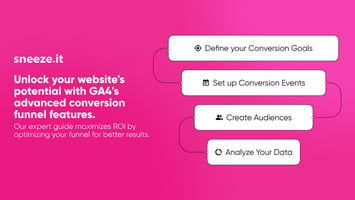Welcome to our comprehensive guide on how to recreate the conversion funnel for GA4. As proficient...
What is an ADA-Compliant Website? Your Complete Guide
 Businesses need to have an online presence, especially since most people prefer to shop or access online information. However, creating a website isn't enough; it must be accessible to everyone, including individuals with disabilities. This is where ADA compliance comes in.
Businesses need to have an online presence, especially since most people prefer to shop or access online information. However, creating a website isn't enough; it must be accessible to everyone, including individuals with disabilities. This is where ADA compliance comes in.
ADA stands for the Americans with Disabilities Act, a civil rights law prohibiting discrimination against individuals with disabilities in all areas of life. This law applies to both physical and virtual spaces, including websites.
An ADA-compliant website follows the guidelines set by the Web Content Accessibility Guidelines (WCAG) to ensure that individuals with disabilities can access the website without any barriers. The WCAG provides recommendations covering a wide range of disabilities, including visual, auditory, cognitive, and physical disabilities.
Why is ADA Compliance Important for Websites?
ADA compliance is not only a legal requirement but also a moral obligation. An ADA-compliant website ensures that individuals with disabilities can access and use the website just like anyone else. This means businesses can reach a wider audience and tap into a previously untapped market. It also helps build customer trust and credibility and shows that the business values diversity and inclusivity.
Moreover, ADA compliance can also improve the website's search engine optimization (SEO) and rank on Google. Google's algorithms prioritize websites that are easy to navigate and accessible to all users, including those with disabilities. Therefore, an ADA-compliant website can help to improve the website's visibility and attract more traffic.
How to Make Your Website ADA-Compliant?
Making a website ADA-compliant involves a range of considerations, from website design to content creation. Here are some of the essential steps to take:
- Use an Accessible Website Design
An accessible website design ensures that all users can access the website regardless of their abilities. This includes using clear, easy-to-read fonts, high color contrast, and logical page structures. It also involves creating a responsive design that works well on different devices, including desktops, laptops, tablets, and smartphones.
- Provide Alternative Text for Images and Multimedia
Alternative or alt text describes an image or multimedia content that allows individuals with visual impairments to understand the content. It is also helpful for individuals who use screen readers or have a slow internet connection. Therefore, including alt text for all images and multimedia content on the website is crucial.
- Create Accessible Forms
Forms are crucial to many websites, including contact forms, registration forms, and checkout forms. To make forms accessible, it's essential to include labels for all form fields and ensure that the form is easy to navigate using a keyboard. It's also important to provide clear instructions and error messages to help users complete the form accurately.
- Ensure Video and Audio Content is Accessible
Video and audio content can be challenging for individuals with hearing impairments. Therefore, it's essential to include closed captions, transcripts, or audio descriptions for all video and audio content on the website. This ensures that individuals with hearing impairments can understand the content.
- Make the Website Keyboard Accessible
Individuals with physical disabilities may be unable to use a mouse to navigate the website. Therefore, it's essential to ensure the website is keyboard accessible, meaning that all website functions can be performed using only the keyboard.
- Conduct Regular Accessibility Audits
Creating an ADA-compliant website is not a one-time task but an ongoing process. It's essential to conduct regular accessibility audits to ensure the website remains accessible and compliant with the latest WCAG guidelines. This involves testing the website using assistive technologies and user testing with individuals with disabilities.
An ADA-compliant website is essential for businesses that want to reach a wider audience and demonstrate their commitment to diversity and inclusivity. It's a legal requirement and a moral obligation to ensure that all individuals, including those with disabilities, can access and use the website. By following the WCAG guidelines and implementing accessible website design, alternative text for images and multimedia, accessible forms, accessible video and audio content, keyboard accessibility, and regular accessibility audits, businesses can create an ADA-compliant website that improves their SEO, visibility, and credibility.
In conclusion, making a website ADA-compliant is not just the right thing to do, but it can also positively impact the business. By providing equal access to all users, businesses can create a more inclusive and welcoming online environment that benefits everyone.
Wondering if your website is ADA-compliant? Book a meeting with Dirk below, and we'll go over your site together, and make sure it's following ADA compliance and all other best practices.






.jpg?height=200&name=Blog%20post%2061%20(1).jpg)